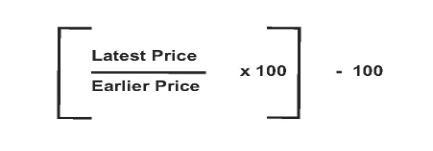Your feedback can help us improve and enhance our services to the public. Tell us what matters to you in our online Customer Satisfaction Survey.
A Price index tell us the percentage change in prices over time. It does not tell us anything about actual price level.
If we compare index numbers for two different products, we can say that the price of one product is rising or falling, faster or slower, than the other. We cannot tell from the index numbers which product is more expensive.
Example 4: Compare two products: Bread and a Motor car
Index numbers are given for bread and a motor car. Both index series begin at 100 in December 2006, the base reference period. We may say both sets of index numbers are Base Dec 2006=100.
| Table 2: | Index numbers for Bread & a Motor car Base: December 2006 = 100 |
||
| Period | Bread | Motor car | |
| Dec 2006 | 100.0 | 100.0 | |
| Jan 2007 | 100.0 | 100.3 | |
| Feb 2007 | 99.7 | 100.3 | |
| Mar 2007 | 102.7 | 100.4 | |
| Apr 2007 | 104.4 | 100.4 | |
| May 2007 | 105.0 | 100.4 | |
| Jun 2007 | 106.2 | 100.6 | |
| Jul 2007 | 106.2 | 100.6 | |
| Aug 2007 | 106.3 | 100.6 | |
| Sep 2007 | 106.1 | 100.6 | |
| Oct 2007 | 113.7 | 100.6 | |
| Nov 2007 | 115.6 | 100.7 | |
| Dec 2007 | 119.7 | 100.7 | |
To calculate the change in price of bread between January 2007 and December 2007 apply this formula:
Formula 2:

Then for bread

By repeating this exercise for a motor car we can see that car prices increased by 0.4%. This means that the price of bread increased by more (in percentage terms) than the price of a motor car between January and December 2007.
Example 5:
For example, in January 2007 the average price of a loaf of bread is 97c and the average cost of a motor car is €20,000. The motor car is much more expensive than a loaf of bread.
In July 2007 the average cost of a motor car rose to €20,060 and a loaf of bread costs €1.03. For which product did the average price change the most? We can work this out using this formula:
Formula 3:

then for motor cars

and for bread

This has been represented by index numbers in Table 2. The index number for bread in July 2007 is 106.2. The index number for motor cars in July 2007 is 100.6. If you use these index numbers with formula 2 you will get the same percentage changes.
If bread cost on average €1.45 in January 2007 and the price increased to €1.54 in July 2007, the percentage change would still be 6.2%. Using the index numbers we still get the same answer. So an index only tells us about the change in price. It does not tell us anything about the actual or absolute price level.
Remember -